2 Guys Buying Comics, the latest addition to my "must read" blogs has proclaimed that this is "First Comic Week", creating a nice blog meme asking folks to talk about their very first comic. How could I pass this up? The biggest problem with the idea of a "first comic" is that I honestly have no clue what the first comic book that ever caught my interest was; I got hooked on my uncle's comic book collection before I can remember, so it's highly possible that my first comic was Nova #1 which I don't recall ever seeing at the time, but which my uncle says my young toddler hands destroyed. However, while narrowing down whether I was first entranced by
The biggest problem with the idea of a "first comic" is that I honestly have no clue what the first comic book that ever caught my interest was; I got hooked on my uncle's comic book collection before I can remember, so it's highly possible that my first comic was Nova #1 which I don't recall ever seeing at the time, but which my uncle says my young toddler hands destroyed. However, while narrowing down whether I was first entranced by 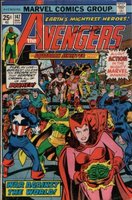 Avengers #147 and the appearance of the Squadron Supreme or by my cousin's issue of Showcase #100 which featured practically every
Avengers #147 and the appearance of the Squadron Supreme or by my cousin's issue of Showcase #100 which featured practically every  character to ever appear in that book is next to impossible, thanks to the beauty of the Grand Comics Database I was able to narrow down the list of suspects for the first comics I ever purchased myself. Being the sort to go overboard in all things (and, being totally overwhelmed by nostalgia by the whole process), I've decided to not just focus on my first comic, but on my first year of comic purchasing which, if my calculations are correct, began with the cover date of February, 1979. And what would that first crucial title be?
character to ever appear in that book is next to impossible, thanks to the beauty of the Grand Comics Database I was able to narrow down the list of suspects for the first comics I ever purchased myself. Being the sort to go overboard in all things (and, being totally overwhelmed by nostalgia by the whole process), I've decided to not just focus on my first comic, but on my first year of comic purchasing which, if my calculations are correct, began with the cover date of February, 1979. And what would that first crucial title be?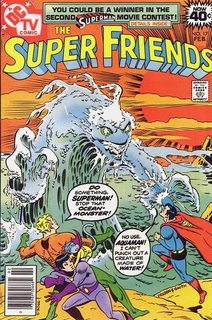 Super Friends #17 Feb. 1979. Honestly, I feel embarrassed that this is the first comic book I ever purchased. Not because it was Super Friends; well, not just because it was Super Friends. No, I'm embarrassed because there's absolutely nothing about this cover that I find appealing today. Which bring up an interesting point; not a single one of my well-worn issues of Super Friends still has a cover; heck I'm not sure any of them still have all of their pages.
Super Friends #17 Feb. 1979. Honestly, I feel embarrassed that this is the first comic book I ever purchased. Not because it was Super Friends; well, not just because it was Super Friends. No, I'm embarrassed because there's absolutely nothing about this cover that I find appealing today. Which bring up an interesting point; not a single one of my well-worn issues of Super Friends still has a cover; heck I'm not sure any of them still have all of their pages. 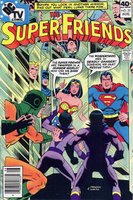 In fact, it's been so long since I've seen any of the covers that I had to double-check that this #17 was even the issue I thought it was, since the cover left me so under-whelmed. Even the story inside isn't all that great, all things considered; the Super Friends have been separated and tossed through time and space and have to find a way to survive. Of course, this issue did serve to instruct me in a few of the basic rules of the pre-Crisis DC universe, like the idea that the whole red/yellow sun thing wasn't just a Kryptonian thing, so that if a sun suddenly turned blue or white normal humans would suddenly become like Superman.
In fact, it's been so long since I've seen any of the covers that I had to double-check that this #17 was even the issue I thought it was, since the cover left me so under-whelmed. Even the story inside isn't all that great, all things considered; the Super Friends have been separated and tossed through time and space and have to find a way to survive. Of course, this issue did serve to instruct me in a few of the basic rules of the pre-Crisis DC universe, like the idea that the whole red/yellow sun thing wasn't just a Kryptonian thing, so that if a sun suddenly turned blue or white normal humans would suddenly become like Superman. But while this issue doesn't hold up as well under my present-day scrutiny, I'm much more forgiving of the other issues of the series I purchased. For example, there's #23, which featured the Wonder Twins squaring off against the Mirror Master; #24, featuring the Wonder Twins evil twins; the Halloween themed #28 featuring Felix Faust and faux versions of Swamp Thing, Bizarro, Solomon Grundy, and The Demon (and which is one of the earliest memories I have of buying a book solely because of the cool cover);
But while this issue doesn't hold up as well under my present-day scrutiny, I'm much more forgiving of the other issues of the series I purchased. For example, there's #23, which featured the Wonder Twins squaring off against the Mirror Master; #24, featuring the Wonder Twins evil twins; the Halloween themed #28 featuring Felix Faust and faux versions of Swamp Thing, Bizarro, Solomon Grundy, and The Demon (and which is one of the earliest memories I have of buying a book solely because of the cool cover); 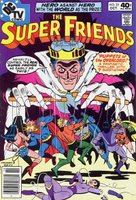 and my favorite of my Year One purchases, #25, where the mind controlled Super Friends try to take over the world and are stopped by a wide range of international heroes including future Justice League members Green Fury (who would later become Fire) and Tasmanian Devil, as well as Wonder Woman's African counterpart, Nubia. That's right, Nubia.
and my favorite of my Year One purchases, #25, where the mind controlled Super Friends try to take over the world and are stopped by a wide range of international heroes including future Justice League members Green Fury (who would later become Fire) and Tasmanian Devil, as well as Wonder Woman's African counterpart, Nubia. That's right, Nubia.
Man, sometimes I miss the 70s.
Seriously, how cool would that cover be to a four year old? One month after picking up my first issue of Super Friends I moved on to the series it was descended from with Justice League of America #164 (March, 1979). Again, the cover doesn't strike the 30-year old me as anything that would catch my eye, but the story inside had more than enough off the wall goodness to keep my young mind entertained. While the cover focuses entirely on Zatanna's search for her mother, the first half of the book is actually concerned with the League's battle with Anton Allegro and his magic synthesizer. There's a great scene where Zatanna uses her backwards spell casting to give all of her teammates magic earmuffs to block out Allegro's attack;
One month after picking up my first issue of Super Friends I moved on to the series it was descended from with Justice League of America #164 (March, 1979). Again, the cover doesn't strike the 30-year old me as anything that would catch my eye, but the story inside had more than enough off the wall goodness to keep my young mind entertained. While the cover focuses entirely on Zatanna's search for her mother, the first half of the book is actually concerned with the League's battle with Anton Allegro and his magic synthesizer. There's a great scene where Zatanna uses her backwards spell casting to give all of her teammates magic earmuffs to block out Allegro's attack; again, I really miss the 70s. I only bought one other issue of JLA during that first year, but it was a doozy: #171 (Oct. 1979), featuring not only a JLA/JSA team-up, which helped to fuel my love for all things Earth-2 already kindled by a few of my uncle's comics, but also the death of a hero. True, it was Mr. Terrific, someone I'd never heard of before, but still a pretty significant event. Unfortunately, it would be many, many years before I would be able to track down #172 and finally find out who the culprit was.
again, I really miss the 70s. I only bought one other issue of JLA during that first year, but it was a doozy: #171 (Oct. 1979), featuring not only a JLA/JSA team-up, which helped to fuel my love for all things Earth-2 already kindled by a few of my uncle's comics, but also the death of a hero. True, it was Mr. Terrific, someone I'd never heard of before, but still a pretty significant event. Unfortunately, it would be many, many years before I would be able to track down #172 and finally find out who the culprit was. The next month I branched out to my first solo title with The Flash #272 (April 1979). Now, as goofy as the cover might seem (homicidal clown using a super-calliope to paralyze The Flash), I can see why it would have appealed to almost-4-year-old Cap'n Neurotic. Like a lot of titles at the time, the cover story only took up the first part of the book, while the second half set up a couple of mysteries which would consume the next several months of the series, primarily the creation of a character who I'm sure almost nobody else remembers, but who holds a special place in my comic geek heart:
The next month I branched out to my first solo title with The Flash #272 (April 1979). Now, as goofy as the cover might seem (homicidal clown using a super-calliope to paralyze The Flash), I can see why it would have appealed to almost-4-year-old Cap'n Neurotic. Like a lot of titles at the time, the cover story only took up the first part of the book, while the second half set up a couple of mysteries which would consume the next several months of the series, primarily the creation of a character who I'm sure almost nobody else remembers, but who holds a special place in my comic geek heart: 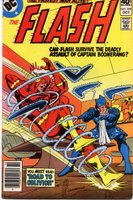 Clive Yorkin, crazed emotional vampire who for a time was the primary suspect in the death of The Flash's wife. Yorkin would play a big part of the next issue I bought, #278 (Oct. 1979), which also introduced me to perennial Flash villains Captain Boomerang and Heatwave;
Clive Yorkin, crazed emotional vampire who for a time was the primary suspect in the death of The Flash's wife. Yorkin would play a big part of the next issue I bought, #278 (Oct. 1979), which also introduced me to perennial Flash villains Captain Boomerang and Heatwave; the scene where Flash kicks Boomer's butt was one of my favorite sequences of any book back then. It was rivaled only by the fight with Professor Zoom, the Reverse Flash, a few issues later in #281 (Jan. 1980). Surprisingly enough, the Zoom-splits-in-half thing promised by that eye-catching cover actually happens in the book itself.
the scene where Flash kicks Boomer's butt was one of my favorite sequences of any book back then. It was rivaled only by the fight with Professor Zoom, the Reverse Flash, a few issues later in #281 (Jan. 1980). Surprisingly enough, the Zoom-splits-in-half thing promised by that eye-catching cover actually happens in the book itself.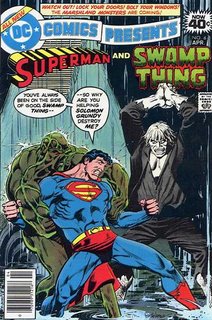 That same month I picked up my first Flash I also picked up the Superman team-up title DC Comics Presents #8 (April 1979). Again, not sure exactly what possessed young Cap'n N. to pick this title up, although I have a vague thought that this one was purchased for me, not necessarily by me; I could be wrong. Anyway, the comic itself is filled with all sorts of freaky scenes, like Swamp Thing having his arm ripped off and then slowly growing a new one, or him accidentally creating an army of Solomon Grundys, all of which probably added to the appeal. This is also the first comic I have a really strong recollection of making my dad sit down and listen to me read out loud.
That same month I picked up my first Flash I also picked up the Superman team-up title DC Comics Presents #8 (April 1979). Again, not sure exactly what possessed young Cap'n N. to pick this title up, although I have a vague thought that this one was purchased for me, not necessarily by me; I could be wrong. Anyway, the comic itself is filled with all sorts of freaky scenes, like Swamp Thing having his arm ripped off and then slowly growing a new one, or him accidentally creating an army of Solomon Grundys, all of which probably added to the appeal. This is also the first comic I have a really strong recollection of making my dad sit down and listen to me read out loud.  I also picked up #16 (Dec. 1979( guest-starring Black Lightning; this issue confused the heck out of me at the time, as it featured a character who jumped all over the evolutionary ladder, a concept that I wasn't quite up to speed with at the time. Plus, the whole "Black Lightning puts on an afro wig as part of his costume" thing didn't quite make sense to me at the time.
I also picked up #16 (Dec. 1979( guest-starring Black Lightning; this issue confused the heck out of me at the time, as it featured a character who jumped all over the evolutionary ladder, a concept that I wasn't quite up to speed with at the time. Plus, the whole "Black Lightning puts on an afro wig as part of his costume" thing didn't quite make sense to me at the time.
 The next month I continued my exploration of the DC universe with Green Lantern/Green Arrow #116 (May 1979). This is another case of "I don't remember ever seeing that cover before in my life!" Also, this issue features an obscure villain that always springs to my mind when I think of GL, but which probably only a handful of other comic geeks know exists: The Crumbler. I always liked the visual effects of his power, for some reason, which is probably one of the reasons he's stuck out in my mind for so long. For once, I actually bought the subsequent issue, #117 (June, 1979) which featured the first time Guy Gardner donned the power ring; I just re-read this last night, and it's really odd to see a hesitant, unsure Guy, as opposed to the loony toons versions of Guy which would dominate during Giffen's run on the Justice League titles in the 90s.
The next month I continued my exploration of the DC universe with Green Lantern/Green Arrow #116 (May 1979). This is another case of "I don't remember ever seeing that cover before in my life!" Also, this issue features an obscure villain that always springs to my mind when I think of GL, but which probably only a handful of other comic geeks know exists: The Crumbler. I always liked the visual effects of his power, for some reason, which is probably one of the reasons he's stuck out in my mind for so long. For once, I actually bought the subsequent issue, #117 (June, 1979) which featured the first time Guy Gardner donned the power ring; I just re-read this last night, and it's really odd to see a hesitant, unsure Guy, as opposed to the loony toons versions of Guy which would dominate during Giffen's run on the Justice League titles in the 90s.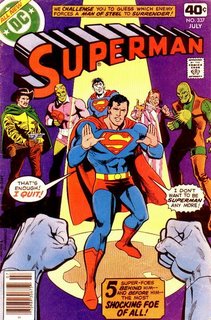 My next new title to purchase was Superman #337 (July 1979). I've never been a big Superman fan, and would buy very few issues of this series over the years; in fact, the next issue I wound up buying years later was a direct result of my early love of this issue. The premise of the issue is that Superman is having a horrible day, as he's attacked by one super-villain after another, from the well-known (Brainiac, Bizarro), to the moderately well-known (Metallo, Toy Man), to the "who the heck is that cowboy, and why does his horse have wings?" (Terra Man). This issue would color my perceptions of each of these villains for years, even though they all turned out to be imposters . . . but perhaps I've said too much. Anyway, the character of Terra Man was just oddball enough for me to pick up any other book I saw with him on the cover, hence the later issues purchased.
My next new title to purchase was Superman #337 (July 1979). I've never been a big Superman fan, and would buy very few issues of this series over the years; in fact, the next issue I wound up buying years later was a direct result of my early love of this issue. The premise of the issue is that Superman is having a horrible day, as he's attacked by one super-villain after another, from the well-known (Brainiac, Bizarro), to the moderately well-known (Metallo, Toy Man), to the "who the heck is that cowboy, and why does his horse have wings?" (Terra Man). This issue would color my perceptions of each of these villains for years, even though they all turned out to be imposters . . . but perhaps I've said too much. Anyway, the character of Terra Man was just oddball enough for me to pick up any other book I saw with him on the cover, hence the later issues purchased.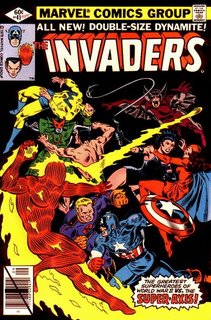 Look, an actual Marvel title! Will wonders never cease? That's right, it took me around 8 months to finally join the ranks of Marvel consumers with my purchase of The Invaders #41 (Sept 1979). Another book whose cover has been gone forever, but as soon as I saw the scan on GCD I thought "that's it!" From what I can tell, this was actually the last issue of the series, and it’s pretty much non-stop action. Don't know for sure when I figured out that the series was set during WWII; I do know that the character of U-Man was directly responsible for me learning what a U-boat was.
Look, an actual Marvel title! Will wonders never cease? That's right, it took me around 8 months to finally join the ranks of Marvel consumers with my purchase of The Invaders #41 (Sept 1979). Another book whose cover has been gone forever, but as soon as I saw the scan on GCD I thought "that's it!" From what I can tell, this was actually the last issue of the series, and it’s pretty much non-stop action. Don't know for sure when I figured out that the series was set during WWII; I do know that the character of U-Man was directly responsible for me learning what a U-boat was.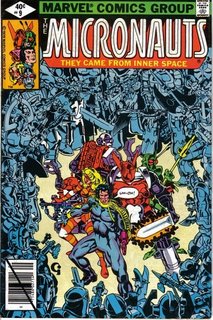 Once the Marvel floodgates were open, they just didn't stop: next up was Micronauts #9 (Sept 1979). I had already been exposed to the Micronauts thanks to my cousin having a couple of issues, but this was a world of difference. His issues were set on Earth, where the heroes were the size of toys; this issue was set in the Microverse (yes, the Microverse) and introduced the warrior world of Sparta (a name which meant nothing to me at the time, but which now makes me roll my eyes). Even though I had a great love for the Micronauts at the time, the series was hard to find in my neck of the woods, and it would be many years before I would be able to expand my collection.
Once the Marvel floodgates were open, they just didn't stop: next up was Micronauts #9 (Sept 1979). I had already been exposed to the Micronauts thanks to my cousin having a couple of issues, but this was a world of difference. His issues were set on Earth, where the heroes were the size of toys; this issue was set in the Microverse (yes, the Microverse) and introduced the warrior world of Sparta (a name which meant nothing to me at the time, but which now makes me roll my eyes). Even though I had a great love for the Micronauts at the time, the series was hard to find in my neck of the woods, and it would be many years before I would be able to expand my collection.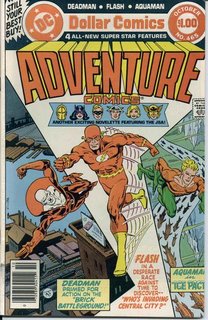 Next up I made a return to DC with the anthology title Adventure Comics #465 (Sept/Oct 1979) which featured four different stories: a Flash story where he talks to dolphins; an Aquaman story where he deals with underwater villains in Arctic waters; a Deadman story which boggled my young mind because I didn't realize that the reason nobody was reacting to his speeches was that nobody could see Boston at all; and, last but definitely not least, a Justice Society of America story which introduced me to The Huntress and prepared me for the JLA/JSA team-up that was to come out a month later.
Next up I made a return to DC with the anthology title Adventure Comics #465 (Sept/Oct 1979) which featured four different stories: a Flash story where he talks to dolphins; an Aquaman story where he deals with underwater villains in Arctic waters; a Deadman story which boggled my young mind because I didn't realize that the reason nobody was reacting to his speeches was that nobody could see Boston at all; and, last but definitely not least, a Justice Society of America story which introduced me to The Huntress and prepared me for the JLA/JSA team-up that was to come out a month later. Finally, we finish up my first year of comic buying with the reprint series Marvel Super Action #15 (Jan 1980), which featured an early adventure of the Avengers where they traveled back in time and witnessed the death of Captain America's sidekick, Bucky, a pretty pivotal event in the Marvel Universe. My grasp of the Avengers was pretty weird at this point in time, since I had gorged myself on all of my uncle's Avengers comics, which spanned a huge amount of time, from the first line-up, to the first big line-up change, to the days of the Serpent Crown saga. I had no clue how it all fit together chronologically, and yet it didn't matter; all that mattered was that they were all really, really cool, and I couldn't wait to read more.
Finally, we finish up my first year of comic buying with the reprint series Marvel Super Action #15 (Jan 1980), which featured an early adventure of the Avengers where they traveled back in time and witnessed the death of Captain America's sidekick, Bucky, a pretty pivotal event in the Marvel Universe. My grasp of the Avengers was pretty weird at this point in time, since I had gorged myself on all of my uncle's Avengers comics, which spanned a huge amount of time, from the first line-up, to the first big line-up change, to the days of the Serpent Crown saga. I had no clue how it all fit together chronologically, and yet it didn't matter; all that mattered was that they were all really, really cool, and I couldn't wait to read more.
And thus ends a brief (well, briefer than it could have been) run-down of my first year of comic buying as best as I can recollect; if I were to extend it just a mere two months, you would get to hear about the first issue of Uncanny X-men I ever got, smack dab in the middle of the Dark Phoenix Saga, but that's a story for another time.
Friday, April 14, 2006
First Comic Week
Posted by
Cap'n Neurotic
at
12:21:00 AM
![]()
Labels: Comic Books
Subscribe to:
Post Comments (Atom)

2 comments:
Interesting. This is one of the "First Comic" stories I've read that had a split Marvel/DC focus!
Thanks for checking in; dig the blog!
I've never really considered myself a total Marvel or DC guy; I've gone through periods where I gravitate more towards one or the other (for example, I'm all about the DC nowadays), but I've never been an exclusive purveyor of either.
Post a Comment